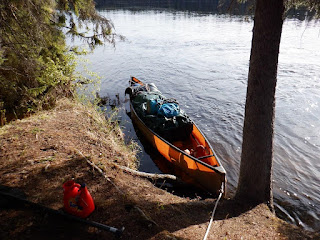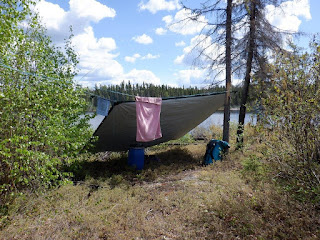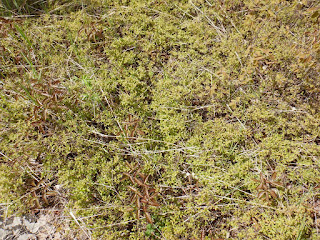Canoe load covered with Tarp, ready to leave camp 2.
Headed down the bay from the falls at camp 2, around a peninsula through a narrow channel, then past mainland until finally moving north again to start the trip down a stretch of very long relatively narrow lake. Before reaching the big turn I was starting to get hit with a headwind and I wanted to be able get past before it became difficult to paddle.
Two male and a female common mergansers, the most common duck I see in northern Saskatchewan; behind them are two common loons. Previously I have camped at a nearby location but it is very exposed and I swore never to camp there again unless absolutely necessary. The problem is that good campsites along this stretch of lake are hard to find, much of the shoreline being very steep.
Farther on can be seen the old burned over areas on the west side.
Stopping at noon just down the lake past an hydroelectric powerline at a narrows (top photo), having travelled 19 km, plus one extra km searching for a campsite. I consider 16 km a fair distance on flat water and so have made good progress. The campsite is not ideal because there are only four moderate size trees to provide some shade, but the tent is sheltered by some thick brush in a bit of a draw. There is really only one good spot to raise the Tarp shelter, with a dead tree at one end and birch saplings at the other to anchor it; bracing one birch with a rope to several others holds the upper rope taut enough. The lower rope is tied to fire-killed down trees. To provide shade from the afternoon sun I rig a medium size tarp across the front of the big Tarp.
The campsite area has a wealth of edible plants, some useful now, others later in the season though may not be productive if they dry out which is likely here. At this campsite I did have some of these for fresh salad. Do not pull the roots so that plants will continue to grow. (Listed below in parentheses are the edible parts of each plant in the appropriate season.)
Clover (leaves, flowers, stems).
Violet (flowers, leaves).
Saskatoon berry or serviceberry shrubs with white flowers (berries).
Dandelion (flowers, leaves).
Wild strawberry (flowers, leaves, berries).
Blueberry (berries).
Alder (catkins, leaves).
Willow, two different species (catkins, leaves).
Wild or false sarsaparilla (ripe berries, main roots) (leave secondary roots to continue to grow).
Birch (leaves, catkins)
Raspberry (berries).
Fireweed (leaves, stems, flowers).
**********************
Summary:
Travel 19 km, plus one extra km searching for a campsite, a good flat-water distance. Camp at a poorly treed area, hot with little shade. Campsite has many edible plants.
June 8:
Up by 03:30. At previous camps on rising I used a candle in the canvas Tent, but this morning though still a bit dark I can see well enough. It is 10°C, clear and calm so I start a small fire to warm up, but still manage to leave by 07:00, a better time than the first camp. Two pelicans from the falls escort me down the bay. I make good time as it is calm most of the way to where I must turn to head down the long narrow lake towards the exit. My mind is telling me there should be a good camp area where I want to stop but it seems to be fictional, probably a spot on another lake somewhere that I am thinking about. At 12 km I stop where I have stayed before, with intentions to camp. As I did a few years ago I tromp the bush looking for a better tent site than the open exposed area which now seems more uneven and rough ... repeating the same process over again expecting different results. After eating lunch, I decide to move on to find a better location. I initiated the SPOT™ device when I stopped so my contacts may wonder why when they receive another message farther down the lake. Counting this one, I stop five times to check for a campsite, to no avail, three on mainland, two on islands. They would all be hard luck sites by my definition. On the biggest island I find an overgrown stone fireplace from long ago high above the lake but do not see how water was easily fetched or a level spot to camp. The best site is beside a gigantic spruce tree well branched to the ground. It would probably be dry under the branches in most rains, but a steep climb up the bank and clearing required for tent and Tarp, with no safe spot for fireplace. At one spot, a male spruce grouse stands on the ground just a few metres away as I search for a tent site. While paddling today I see several pelicans and bald eagles, hear warblers singing merrily in all the bush regrowth areas.
The land on the west side of the lake was all burned in 2017. Just past an hydroelectric power line crossing the first narrows, I decide to camp at an open burned area that has a grassy area and much new growth of brush and slender birch trees plus many edible plants. Thankfully there are four surviving medium size pine and spruce trees by water's edge. I have travelled a distance of 19 km plus one extra km searching for a campsite. This spot was burned at least 10 years ago, a good thing because it had been used as a picnic site with much garbage still littering the ground; people motorboat in from the distant highway. Not happy about having to camp here, I know that if I continue, I may not find a suitable spot for some distance. It takes an hour to clear a tent site of small alder, birch, rose and blueberry bushes. I am sweating and attract bothersome blackflies so start a smoky fire to shoo them away before erecting the tent and Tarp shelter. I manage to find enough stones for the fireplace but douse the area all around it with water to prevent spread. Hot and sweaty I drink several litres of water through the LifeStraw® water filter as I set up camp. My younger self convinces my older self to just camp overnight and then leave for a better site, less exposed and with bigger trees. If it rains much this site will be uncomfortable. However, as time marches on my older self prevails to stay one more day. Just before bedtime at 21:30, two pelicans paddle past, their large feet very efficient oars.
June 9:
Thank goodness I decided to stay another day; my sore right shoulder appreciates it. The rest at night seems to help, but activity seems to help too? ... I hope. Finally, my first successful bannock with the revised ingredients. Yay! I add a measured ¼ cup of potable water, mixing well with a spoon. Knead well to avoid cracks in the dough. Flatten with fingertips but not full diameter of the pan to keep intact. If broken, knead again and repeat. Lift bannock and sprinkle cornmeal in the 8½" round pan. Flatten to within one cm of the edge, tidying edges inward. Pick bannock up and sprinkle cornmeal in pan again. Invert bannock and turn to work some cornmeal into the dough. Place pan tipped at 60° angle at a spot by the fire where the back of hand can be held for four seconds (about 350°F). When lower half of first side browned, rotate pan 180° to brown the other half. Gently turn hot bannock upside down into mitted hand, invert into pan and repeat bake procedure. Rest bannock one minute and slice into quadrants. Place three into another pan to cool for packing, each in a small Ziploc® bag. Eat the fresh fourth piece plus crumbs. Still not as tasty as my old cinnamon bannock recipe but it will do, the advantage being that I do not have to separately pack butter in coolers.
Temperature increases from 10°C on rising at 06:30 to 22°C by noon and a hot 27°C later with a moderate wind that helps to keep bothersome blackflies at bay, which like to get under the hat brim on my forehead, in the lee of the wind as I sit with back to sun ... little buggers! I could not stand the garbage anymore and started cleaning up at breakfast, burning any plastic and throwing cans, boards and metal away from the site in the brush ... out-of-sight, out-of-mind! There is an old bear scat in the grass and some rubbed hair on one spruce tree, nothing recent. Sweaty, I have a welcome hot shower, cool in the wind but sure feels great. I sit in the shade of the four bigger trees and an alder bush for breakfast and lunch, moving my chair as the sun heads west, then in the shelter of a birch grove for supper. The tent has been in full sun all day so sleep gear is well dried, and like last night I go to bed almost naked, laying on a cotton sheet on the bed. Sometime around midnight a migrating flock of honking Canada geese wake me as they fly just over camp to land in the bay above me, the rush of air through their wings very noticeable. Awesome!














































